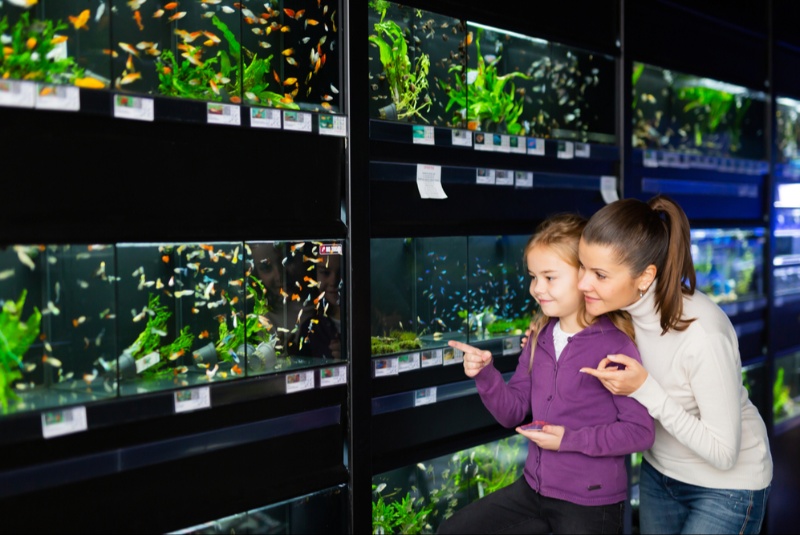Setting up a home aquarium can be a rewarding hobby that brings tranquility and beauty into your living space. However, buying fish requires careful consideration to ensure a healthy and harmonious environment for your aquatic pets. This guide provides essential tips and insights for selecting the right fish for your home aquarium, ensuring you create a thriving underwater ecosystem.
Understanding Aquarium Types
The type of aquarium you choose will influence the fish you can keep. Freshwater aquariums are the most common and are ideal for beginners due to their relatively low maintenance and cost. Saltwater aquariums offer a greater diversity of colorful and exotic fish but require more advanced care and equipment. Brackish aquariums are a mix of both, suitable for certain species that thrive in such conditions. Understanding aquarium types ensures you select fish compatible with your tank setup and maintenance capabilities.
Determining Your Tank Size
The size of your aquarium plays a crucial role in the health and well-being of your fish. A larger tank provides a more stable environment, diluting toxins and offering more space for fish to swim. It also allows for a greater variety of fish. Beginners should consider starting with a tank of at least 20 gallons. Remember, each fish species has specific space requirements. Determining your tank size ensures you can accommodate the fish you want and maintain a healthy environment for them.
Researching Fish Species
Before purchasing fish, research various species to understand their specific needs and compatibility. Consider factors such as water temperature, pH levels, diet, and social behavior. Some fish are peaceful and do well in community tanks, while others are territorial and best kept alone. Understanding the lifespan and growth potential of the fish is also important. Researching fish species ensures you choose fish that can coexist harmoniously and thrive in your aquarium conditions.
Considering Compatibility
Compatibility is key to a harmonious aquarium. Choose fish that have similar requirements in terms of water parameters and diet. Avoid mixing aggressive species with peaceful ones, as this can lead to stress and injury. Use compatibility charts or seek advice from experienced aquarists to create a balanced community tank. Considering compatibility ensures your fish live peacefully together, reducing the risk of conflict and promoting a healthy environment.
Evaluating Fish Health
When buying fish, it's crucial to assess their health to avoid introducing diseases into your aquarium. Look for active, alert fish with bright colors and clear eyes. Avoid fish with visible signs of illness, such as clamped fins, white spots, or unusual swimming patterns. Check the cleanliness of the tank and the condition of other fish in the store. Evaluating fish health ensures you bring home healthy specimens that are more likely to thrive in your aquarium.

Understanding Care Requirements
Each fish species has unique care requirements that must be met to ensure their well-being. Research the specific needs of your chosen fish, including their diet, water conditions, and social behaviors. Understand the level of care involved, from daily feeding to regular tank maintenance. Some fish may require special equipment, such as heaters or filters. Understanding care requirements ensures you are prepared to meet the needs of your fish, promoting their health and longevity.
Setting Up Your Aquarium
Properly setting up your aquarium before introducing fish is essential. Start by thoroughly cleaning the tank, substrate, and decorations. Install necessary equipment such as filters, heaters, and lights. Fill the tank with dechlorinated water and cycle it for several weeks to establish beneficial bacteria. Test water parameters to ensure they are within the acceptable range for your chosen fish. Setting up your aquarium correctly ensures a stable environment that supports the health and well-being of your fish.
Acclimating New Fish
Acclimating new fish to your aquarium is crucial to reduce stress and prevent shock. Float the sealed bag containing the fish in your tank for about 15-20 minutes to equalize the temperature. Gradually add small amounts of tank water to the bag over the next hour to allow the fish to adjust to the water chemistry. After acclimation, gently release the fish into the tank. Acclimating new fish properly ensures a smoother transition and increases their chances of thriving in their new environment.
Monitoring and Maintaining Water Quality
Maintaining optimal water quality is critical for the health of your fish. Regularly test water parameters, including ammonia, nitrite, nitrate, pH, and hardness. Perform partial water changes weekly to remove toxins and replenish essential minerals. Clean the filter and replace filter media as needed. Monitor the behavior and appearance of your fish for signs of stress or illness. Monitoring and maintaining water quality ensures a healthy and stable environment, promoting the well-being of your fish.
Feeding Your Fish
Proper nutrition is vital for the health and growth of your fish. Research the dietary needs of your chosen species and provide a balanced diet. Offer a variety of high-quality foods, such as flakes, pellets, frozen, and live foods, to meet their nutritional requirements. Feed your fish small amounts multiple times a day, avoiding overfeeding, which can lead to water quality issues. Feeding your fish correctly ensures they receive the necessary nutrients for optimal health and vitality.
Handling Common Fish Diseases
Fish can be susceptible to various diseases, often caused by poor water quality, stress, or parasites. Common symptoms include white spots, fin rot, and abnormal swimming behavior. Quarantine new fish before adding them to your main tank to prevent the spread of disease. Treat affected fish promptly with appropriate medications and improve tank conditions to prevent recurrence. Handling common fish diseases effectively ensures you can address health issues swiftly and maintain a healthy aquarium.
Expanding Your Knowledge
Continually expanding your knowledge about fishkeeping can enhance your success and enjoyment of the hobby. Read books, join online forums, and connect with other aquarists to learn from their experiences. Attend workshops or local aquarium club meetings to gain practical insights and tips. Staying informed about new products, techniques, and trends in fishkeeping ensures you can provide the best care for your aquatic pets. Expanding your knowledge fosters a deeper understanding and appreciation of the hobby.
Buying fish for your home aquarium involves careful planning and consideration to ensure a thriving and harmonious environment. By understanding aquarium types, determining tank size, researching fish species, and ensuring compatibility, you can create a balanced and healthy community tank. Evaluating fish health, understanding care requirements, and properly setting up your aquarium are crucial steps. Acclimating new fish, maintaining water quality, feeding correctly, and handling diseases are essential for their well-being. Use this guide to make informed decisions and enjoy the beauty and tranquility of a well-maintained home aquarium




